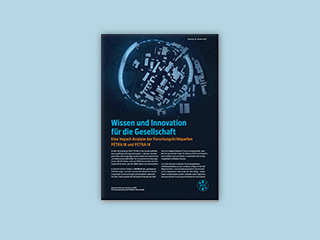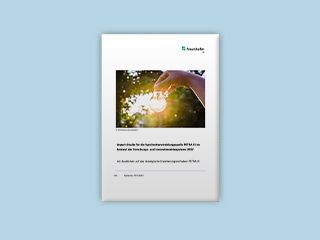
Scientific findings and innovative developments
New study: DESY’s light source PETRA III has created 2.25 billion euros in added value: The PETRA IV upgrade could add a further 7.35 billion euros in value – possibly considerably more.
The study, carried out by the Fraunhofer Institute for Systems and Innovation Research (ISI), shows that DESY is not only a significant driver of scientific progress, thanks to its research radiation sources, but that it also has an economic impact in the region, in Germany and in Europe as an employer and through commissioning of business enterprises.

Between 2010 and 2022, DESY invested some 815 million euros in building and operating PETRA III. As a result, the research facility has produced unique scientific insights and provided essential data for innovative developments.
Their added value amounts to more than 2.25 billion euros.
A summary of the findings can be found here:

Impact-Summary
Even greater additional benefits become apparent once complementary, structural effects are included in the analysis. For example through investments by partner institutes, expenditure by visiting scientists on site, the establishment of further research infrastructures (e.g. by the Center for Structural Systems Biology CSSB and the European Molecular Biology Laboratory EMBL) on campus or the founding of start-ups.
Scientific benefits
Every year, more than 3,500 researchers carry out their experiments at PETRA III; somewhat more than half of them come from Germany. They have published their results in more than 5,200 papers. Eighty percent of these publications contribute directly to socially relevant topics and align with the UN Sustainable Development Goals.

Study Fraunhofer ISI 2023
Fraunhofer ISI
Conversion to PETRA IV: investment in innovation
With its future-oriented PETRA IV project, DESY will lead the use of accelerator-based X-ray light sources into a new era: With a broad portfolio of experimental options and individual support for science and industry, the new accelerator facility is designed to meet the highest requirements and meet the growing demand for non-destructive testing. PETRA IV will then be the most powerful X-ray source in the world and will be equipped with targeted AI tools, allowing data to be widely used for scientific and industrial purposes and to be channelled directly into industrial value chains. DESY plans to reserve around 20 per cent of the measuring time for industry-related projects.
Based on similar calculations to those performed in the study by the Fraunhofer Institute for Systems and Innovation Research (ISI) for PETRA III,
- the investment in PETRA IV will result in additional benefits of more than 7 billion euros, even when considered only as a classical research infrastructure.
X-ray analysis will then serve as a fundamental tool for manufacturing semiconductors and microchips, developing and validating quantum, energy-related and catalytic materials, and for developing drugs and therapeutic treatments. PETRA IV will thereby ensure that the results can be converted directly into product developments and process optimisations in critical industries, in Germany and in Europe as a whole. Time is pressing – similar light sources around the world have long since begun to establish research infrastructures of this kind.
However, DESY is not only planning an upgrade as a scientific infrastructure, but also as a key tool for innovation across all industries. Industry support, data generation, AI advancements and influence on the deep tech start-up scene:
if the planned transformative effects are taken into account, value creation could increase tenfold to up to 24 billion euros over a period of ten years.

Heidrun Hillen
I am happy to answer your questions about PETRA IV.

